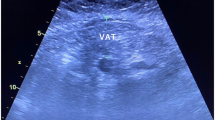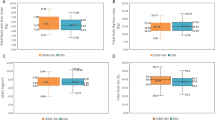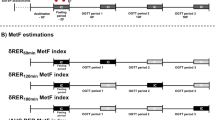Abstract
Background/Objectives:
Heart rate recovery (HRR), a cardiac autonomic control marker, was shown to be related to body composition (BC), yet this was not tested in non-alcoholic fatty liver disease (NAFLD) patients. The aim of this study was to determine if, and to what extent, markers of BC and body fat (BF) distribution are related to cardiac autonomic control in NAFLD patients.
Subjects/Methods:
BC was assessed with dual-energy X-ray absorptiometry in 28 NAFLD patients (19 men, 51±13 years, and 9 women, 47±13 years). BF depots ratios were calculated to assess BF distribution. Subjects’ HRR was recorded 1 (HRR1) and 2 min (HRR2) immediately after a maximum graded exercise test.
Results:
BC and BF distribution were related to HRR; particularly weight, trunk BF and trunk BF-to-appendicular BF ratio showed a negative relation with HRR1 (r=−0.613, r=−0.597 and r=−0.547, respectively, P<0.01) and HRR2 (r=−0.484, r=−0.446, P<0.05, and r=−0.590, P<0.01, respectively). Age seems to be related to both HRR1 and HRR2 except when controlled for BF distribution. The preferred model in multiple regression should include trunk BF-to-appendicular BF ratio and BF to predict HRR1 (r2=0.549; P<0.05), and trunk BF-to-appendicular BF ratio alone to predict HRR2 (r2=0.430; P<0.001).
Conclusions:
BC and BF distribution were related to HRR in NAFLD patients. Trunk BF-to-appendicular BF ratio was the best independent predictor of HRR and therefore may be best related to cardiovascular increased risk, and possibly act as a mediator in age-related cardiac autonomic control variation.
This is a preview of subscription content, access via your institution
Access options
Subscribe to this journal
Receive 12 print issues and online access
$259.00 per year
only $21.58 per issue
Buy this article
- Purchase on Springer Link
- Instant access to full article PDF
Prices may be subject to local taxes which are calculated during checkout
Similar content being viewed by others
References
Bellentani S, Saccoccio G, Masutti F, Croce LS, Brandi G, Sasso F et al. Prevalence of and risk factors for hepatic steatosis in Northern Italy. Ann Intern Med 2000; 132: 112–117.
Nomura H, Kashiwagi S, Hayashi J, Kajiyama W, Tani S, Goto M . Prevalence of fatty liver in a general population of Okinawa, Japan. Jpn J Med 1988; 27: 142–149.
Browning JD, Szczepaniak LS, Dobbins R, Nuremberg P, Horton JD, Cohen JC et al. Prevalence of hepatic steatosis in an urban population in the United States: impact of ethnicity. Hepatology 2004; 40: 1387–1395.
Clark JM . The epidemiology of nonalcoholic fatty liver disease in adults. J Clin Gastroenterol 2006; 40 (Suppl 1), S5–S10.
Cortez-Pinto H, Moura MC, Day CP . Non-alcoholic steatohepatitis: from cell biology to clinical practice. J Hepatol 2006; 44: 197–208.
Angulo P . Nonalcoholic fatty liver disease. N Engl J Med 2002; 346: 1221–1231.
Targher G, Bertolini L, Padovani R, Rodella S, Zoppini G, Pichiri I et al. Prevalence of non-alcoholic fatty liver disease and its association with cardiovascular disease in patients with type 1 diabetes. J Hepatol 2010; 53: 713–718.
Rector RS, Thyfault JP, Uptergrove GM, Morris EM, Naples SP, Borengasser SJ et al. Mitochondrial dysfunction precedes insulin resistance and hepatic steatosis and contributes to the natural history of non-alcoholic fatty liver disease in an obese rodent model. J Hepatol 2010; 52: 727–736.
Cote M, Mauriege P, Bergeron J, Almeras N, Tremblay A, Lemieux I et al. Adiponectinemia in visceral obesity: impact on glucose tolerance and plasma lipoprotein and lipid levels in men. J Clin Endocrinol Metab 2005; 90: 1434–1439.
Gnacinska M, Malgorzewicz S, Stojek M, Lysiak-Szydlowska W, Sworczak K . Role of adipokines in complications related to obesity: a review. Adv Med Sci 2009; 54: 150–157.
Imai K, Sato H, Hori M, Kusuoka H, Ozaki H, Yokoyama H et al. Vagally mediated heart rate recovery after exercise is accelerated in athletes but blunted in patients with chronic heart failure. J Am Coll Cardiol 1994; 24: 1529–1535.
Davrath LR, Akselrod S, Pinhas I, Toledo E, Beck A, Elian D et al. Evaluation of autonomic function underlying slow postexercise heart rate recovery. Med Sci Sports Exerc 2006; 38: 2095–2101.
Cole CR, Blackstone EH, Pashkow FJ, Snader CE, Lauer MS . Heart-rate recovery immediately after exercise as a predictor of mortality. N Engl J Med 1999; 341: 1351–1357.
Vivekananthan DP, Blackstone EH, Pothier CE, Lauer MS . Heart rate recovery after exercise is a predictor of mortality, independent of the angiographic severity of coronary disease. J Am Coll Cardiol 2003; 42: 831–838.
Diaz LA, Brunken RC, Blackstone EH, Snader CE, Lauer MS . Independent contribution of myocardial perfusion defects to exercise capacity and heart rate recovery for prediction of all-cause mortality in patients with known or suspected coronary heart disease. J Am Coll Cardiol 2001; 37: 1558–1564.
Arena R, Guazzi M, Myers J, Peberdy MA . Prognostic value of heart rate recovery in patients with heart failure. Am Heart J. 2006; 151: 851 e7–851.e13.
Cheng YJ, Lauer MS, Earnest CP, Church TS, Kampert JB, Gibbons LW et al. Heart rate recovery following maximal exercise testing as a predictor of cardiovascular disease and all-cause mortality in men with diabetes. Diab Care 2003; 26: 2052–2057.
Lipinski MJ, Vetrovec GW, Froelicher VF . Importance of the first two minutes of heart rate recovery after exercise treadmill testing in predicting mortality and the presence of coronary artery disease in men. Am J Cardiol 2004; 93: 445–449.
Chacko KM, Bauer TA, Dale RA, Dixon JA, Schrier RW, Estacio RO . Heart rate recovery predicts mortality and cardiovascular events in patients with type 2 diabetes. Med Sci Sports Exerc 2008; 40: 288–295.
Carnethon MR, Sternfeld B, Liu K, Jacobs DR Jr., Schreiner PJ, Williams OD et al. Correlates of heart rate recovery over 20 years in a healthy population sample. Med Sci Sports Exerc 2012; 44: 273–279.
Bray GA . Obesity, a disorder of nutrient partitioning: the MONA LISA hypothesis. J Nutr 1991; 121: 1146–1162.
Kim MK, Tanaka K, Kim MJ, Matsuo T, Tomita T, Ohkubo H et al. Epicardial fat tissue: relationship with cardiorespiratory fitness in men. Med Sci Sports Exerc 2010; 42: 463–469.
Esco MR, Williford HN, Olson MS . Skinfold thickness is related to cardiovascular autonomic control as assessed by heart rate variability and heart rate recovery. J Strength Cond Res 2011; 25: 2304–2310.
Kreier F, Kap YS, Mettenleiter TC, van Heijningen C, van der Vliet J, Kalsbeek A et al. Tracing from fat tissue, liver, and pancreas: a neuroanatomical framework for the role of the brain in type 2 diabetes. Endocrinology 2006; 147: 1140–1147.
Kizilbash MA, Carnethon MR, Chan C, Jacobs DR, Sidney S, Liu K . The temporal relationship between heart rate recovery immediately after exercise and the metabolic syndrome: the CARDIA study. Eur Heart J. 2006; 27: 1592–1596.
Christou DD, Jones PP, Pimentel AE, Seals DR . Increased abdominal-to-peripheral fat distribution contributes to altered autonomic-circulatory control with human aging. Am J Physiol Heart Circ Physiol 2004; 287: H1530–H1537.
Nilsson G, Hedberg P, Jonason T, Lonnberg I, Ohrvik J . Heart rate recovery is more strongly associated with the metabolic syndrome, waist circumference, and insulin sensitivity in women than in men among the elderly in the general population. Am Heart J. 2007; 154: 460. e1–e7.
Kamel EG, McNeill G, Van Wijk MC . Usefulness of anthropometry and DXA in predicting intra-abdominal fat in obese men and women. Obes Res 2000; 8: 36–42.
Park YW, Heymsfield SB, Gallagher D . Are dual-energy X-ray absorptiometry regional estimates associated with visceral adipose tissue mass? Int J Obes Relat Metab Disord 2002; 26: 978–983.
Pimenta NM, Santa-Clara H, Sardinha LB, Fernhall B . Body fat responses to a 1-year combined exercise training program in male coronary artery disease patients. Obesity 2013; 21: 723–730.
Lohman TG, Roche AF, Martorell R . Anthropometric Standardization Reference Manual. Human Kinetics: Champaign, IL, USA, 1988.
Savgan-Gurol E, Bredella M, Russell M, Mendes N, Klibanski A, Misra M . Waist to hip ratio and trunk to extremity fat (DXA) are better surrogates for IMCL and for visceral fat respectively than for subcutaneous fat in adolescent girls. Nutr Metab (Lond) 2010; 7: 86.
Ketel IJ, Volman MN, Seidell JC, Stehouwer CD, Twisk JW, Lambalk CB . Superiority of skinfold measurements and waist over waist-to-hip ratio for determination of body fat distribution in a population-based cohort of Caucasian Dutch adults. Eur J Endocrinol 2007; 156: 655–661.
Bruce RA . Exercise testing of patients with coronary heart disease. Principles and normal standards for evaluation. Ann Clin Res 1971; 3: 323–332.
Howley ET, Bassett DR Jr., Welch HG . Criteria for maximal oxygen uptake: review and commentary. Med Sci Sports Exerc 1995; 27: 1292–1301.
Shetler K, Marcus R, Froelicher VF, Vora S, Kalisetti D, Prakash M et al. Heart rate recovery: validation and methodologic issues. J Am Coll Cardiol 2001; 38: 1980–1987.
Carnethon MR, Jacobs DR Jr, Sidney S, Sternfeld B, Gidding SS, Shoushtari C et al. A longitudinal study of physical activity and heart rate recovery: CARDIA, 1987-1993. Med Sci Sports Exerc 2005; 37: 606–612.
Cohen J, Cohen P . Applied Multiple Regression/Correlation Analysis for the Behavioral Sciences 2nd edn Lawrence Erkbaum Associates, Inc: Hillsdale, NJ, 1983, p 545.
Panzer C, Lauer MS, Brieke A, Blackstone E, Hoogwerf B . Association of fasting plasma glucose with heart rate recovery in healthy adults: a population-based study. Diabetes 2002; 51: 803–807.
Hargens TA, Guill SG, Zedalis D, Gregg JM, Nickols-Richardson SM, Herbert WG . Attenuated heart rate recovery following exercise testing in overweight young men with untreated obstructive sleep apnea. Sleep 2008; 31: 104–110.
Chen MS, Blackstone EH, Pothier CE, Lauer MS . Heart rate recovery and impact of myocardial revascularization on long-term mortality. Circulation 2004; 110: 2851–2857.
Hadley DM, Dewey FE, Freeman JV, Myers JN, Froelicher VF . Prediction of cardiovascular death using a novel heart rate recovery parameter. Med Sci Sports Exerc 2008; 40: 1072–1079.
Myers J, Tan SY, Abella J, Aleti V, Froelicher VF . Comparison of the chronotropic response to exercise and heart rate recovery in predicting cardiovascular mortality. Eur J Cardiovasc Prev Rehabil 2007; 14: 215–221.
Nishime EO, Cole CR, Blackstone EH, Pashkow FJ, Lauer MS . Heart rate recovery and treadmill exercise score as predictors of mortality in patients referred for exercise ECG. JAMA 2000; 284: 1392–1398.
Horowitz JF . Adipose tissue lipid metabolism during exercise. In: Hargreaves M, Spriet L (eds). Exercise Metabolism. Human Kinetics: Champaign, IL, USA, 2006, pp 89–104.
Bartness TJ, Song CK . Thematic review series: adipocyte biology. Sympathetic and sensory innervation of white adipose tissue. J Lipid Res 2007; 48: 1655–1672.
Lafontan M, Berlan M . Fat cell adrenergic receptors and the control of white and brown fat cell function. J Lipid Res 1993; 34: 1057–1091.
Bertin E, Marcus C, Ruiz JC, Eschard JP, Leutenegger M . Measurement of visceral adipose tissue by DXA combined with anthropometry in obese humans. Int J Obes Relat Metab Disord 2000; 24: 263–270.
Snijder MB, Visser M, Dekker JM, Seidell JC, Fuerst T, Tylavsky F et al. The prediction of visceral fat by dual-energy X-ray absorptiometry in the elderly: a comparison with computed tomography and anthropometry. Int J Obes Relat Metab Disord 2002; 26: 984–993.
Acknowledgements
The present study was funded by the Centre for the Study of Human Performance, Portuguese Foundation for Science and Technology, Lisbon, Portugal.
Author information
Authors and Affiliations
Corresponding author
Ethics declarations
Competing interests
The authors declare no conflict of interest.
Rights and permissions
About this article
Cite this article
Pimenta, N., Santa-Clara, H., Cortez-Pinto, H. et al. Body composition and body fat distribution are related to cardiac autonomic control in non-alcoholic fatty liver disease patients. Eur J Clin Nutr 68, 241–246 (2014). https://doi.org/10.1038/ejcn.2013.249
Received:
Revised:
Accepted:
Published:
Issue Date:
DOI: https://doi.org/10.1038/ejcn.2013.249
Keywords
This article is cited by
-
Cardiovascular Disease and Myocardial Abnormalities in Nonalcoholic Fatty Liver Disease
Digestive Diseases and Sciences (2016)



